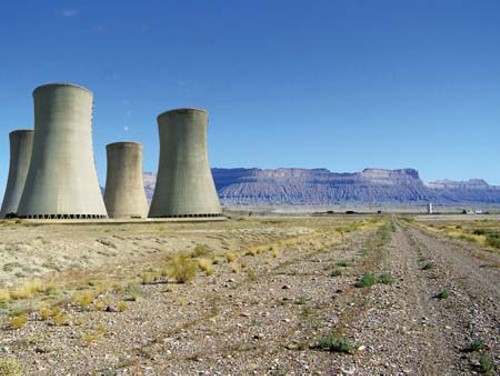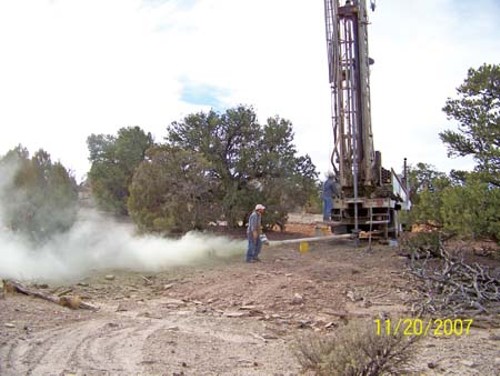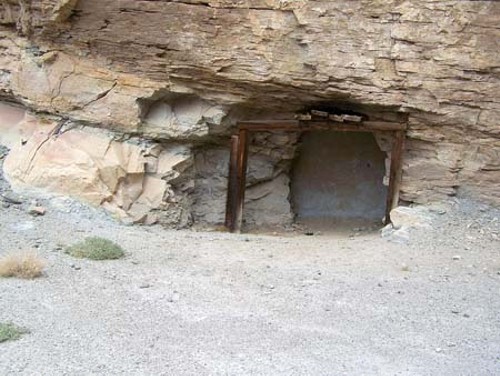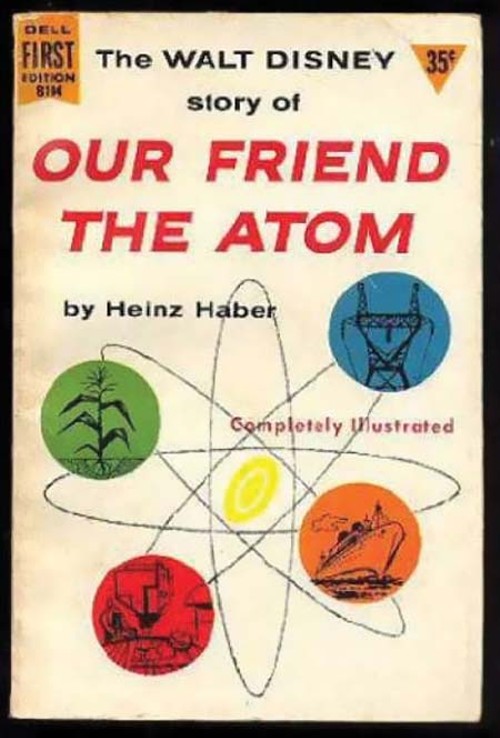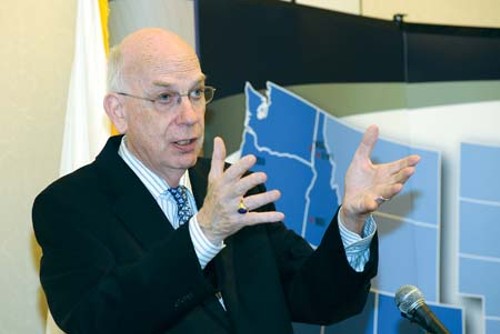Nuclear Utah
Power Mad: How Sen. Bob Bennett learned to stop worrying and love nuclear power plants.
By Katharine Biele @kathybieleIn the Temple Mountain area, the silent, sandstone beauty of the San Rafael Swell is punctuated by tumbleweeds, wind-carved hills and the man-made caves we call mines. McCandless remembers shining a flashlight whose beam never reached the ceiling of one such mine. It’s just an exciting part of the local history, and McCandless, as the head of Emery County’s planning and zoning, economic development and the travel bureau, wants to share the wealth. Literally and figuratively.
Emery County—Green River, specifically—is the chosen site for a future nuclear power plant touted by former Rep. Aaron Tilton, R-Springville, whose holding company, Blue Castle (BlueCastleProject.com), owns and wants to develop the site.
It could be the beginning of a nuclear boom—economically, of course. U.S. Sen. Bob Bennett, R-Utah, wants to start with 100 nuclear power plants around the United States, just to get things going for an industry that’s been stalled for decades. There hasn’t been a new reactor built in the United States since 1977, according to the U.S. Department of Energy, when the River Bend plant went up in Louisiana.
Certainly, the recent energy scare helped fuel the nuclear debate and gave new legs to Tilton’s Blue Castle plan. But the political climate is perhaps hotter than any reactor, and questions still are answered with polarity. This, despite a clear majority of Utahns abuzz about nuclear energy and both the jobs and electricity it promises to bring. According to a 2008 Dan Jones poll, 57 percent of Utahns were OK with the idea of nuclear as part of the state’s future, and fully one-third of those questioned strongly favored the idea.
In June, Bennett held a Republican-sponsored Senate hearing to explore the possibilities and, oh, to eviscerate the Democrats’ proposed cap and trade system of “pollution credits” traded from a less-polluting entity to one that pollutes more. It was a virtual love-fest of nuclear proponents, including senators Lamar Alexander, R-Tenn., Jim Bunning, R-Ky., and Roger Wicker, R-Miss., as they questioned the reality of global warming under their breaths, characterized cap and trade as something of a tax conspiracy to redistribute wealth and pollution, and laid out a proud vision of nuclear cleanliness for the future.
To some on the sidelines, there were a couple of revelations: Republicans say they unanimously agree they want clean air, and they want to “remind” people that they know how to give you pollution-free, carbon-free electricity. “Nuclear power is the proven way to do it,” Alexander said.
Bunning voiced the party line on voluntary pollution goals for industry while providing incentives for nuclear and clean coal.
Also, they no longer think Nevada’s Yucca Mountain is needed for nuclear waste storage. That was a big one. With that $90 billion monster theoretically off the table, nuclear proponents are spreading their wings and going back to the future of nuclear-plant construction.
Bennett, at least, believes the waste problem is solved. He’s been to Areva, he said, using a much-referenced name to this audience of nuclear wonks. Areva is a Frenchowned, energy-service company whose worldwide plans include building a $2 billion uranium enrichment plant at Idaho Falls, Idaho, and whose corporate goal is to “innovate to contribute to CO2-free power generation and electricity transport that are cleaner, safer and more economic.”
Lumps of Coal
In
fact, the carbon issue is one of the driving forces behind the nuclear
rebirthing process. Since 1995, most of the country’s electricity has
come from coal, and when you factor in all fossil sources, you account
for about 72 percent, noted Kevin Book of ClearView Energy Partners.
For Utah, coal is a huge issue, both environmentally and economically. The state is the 12th-biggest coal-producing state in the country, according to SourceWatch, a project of the Center for Media and Democracy.
In 2005, coal accounted for 74 percent of the state’s total electric generating capacity, generated by 16 coal-fired stations. “Utah emitted 25.3 tons of CO per person, about 25 percent higher than the U.S. average,” SourceWatch says. That was 41 million tons of CO, or 66 percent of the state’s total carbon dioxide emissions, plus 34,000 tons of sulfur dioxide, and 68,000 tons of nitrogen oxide. Don’t breathe too deeply.
And while the Republican conference generally agreed that clean-coal emissions are possible, there are experts who demur. “We don’t have carbon sequestration reliably,” says Arjun Makhijani, president of the Institute for Energy and Environmental Research, an anti-nuclear policy organization based in Maryland.
Admittedly, technology is growing around carbon sequestration designed to take carbon dioxide out of the atmosphere and store it, but it’s both expensive and experimental. And it’s mostly of interest to the coal industry itself.
Makhijani is a noted author and expert in nuclear fusion, but he’s also seen as the nuclear Antichrist. His book Carbon-free, Nuclear Free is panned by nuclear proponents as a myth. Even Patrick Moore, a cofounder of Greenpeace, now says he thinks nuclear is the only answer “for large-scale continuous, clean, safe, reliable and costeffective” electricity.
It Will Never Happen Here
Bennett
tried hard to address the issues around nuclear plants by demonstrating
how safe the technology has become—certainly since 1979’s Three Mile
Island meltdown and, later, the 1986 explosion of the Chernobyl nuclear
plant.
Ted Rockwell of the American Nuclear Society went so far as to call Three Mile Island a great success. Everything worked properly. Systems shut down. No one was hurt, and the “China Syndrome”—a movie-born term that has molten fuel burning its way through the Earth—didn’t happen.
“What TMI showed,” said Rockwell, “was that the consequences were zero.” No measurable amount of radiation was found in the vicinity, and the 10- to-20 tons of molten fuel only burned about five-eighths of an inch down, without penetrating the reactor vessel.
Chernobyl was a different animal, of course because the Ukrainians had built it poorly. Chernobyl’s graphite moderator burned for 10 days, spewing radiation throughout the atmosphere. It was just bad technology, Rockwell suggested, it will never happen here.
And the mantra persists: No one in the United States has ever been hurt by nuclear. If that is true, then the U.S. Labor Department has paid more than $5 billion in compensation and benefits to 52,600 sick nuclear-weapons workers for nothing.
“Each step in the process has its own health and safety issues,” says Christopher Thomas of the environmental watchdog group HEAL Utah. “Monticello is still fighting to get money in Congress for cancer screening.”
Monticello had a uranium-processing mill that was shut down in the 1960s, and then much later declared a Superfund cleanup site. Children had played in tailings ponds, while residents had dried their laundry inside for fear of holes burning through their clothes, according to the group Victims of Mill Tailings Exposure.
For another site, the Department of Energy will probably spend $1 billion to clean up uranium tailings left from the Atlas mill near Moab. In fact, there are four abandoned uranium mills in Utah that promise cleanup costs for taxpayers.
Children of the Boom
Support
for the Green River plant has been almost universal from residents of
Emery County. This is a county used to power issues and, in fact, is
dependent on them. The western half of the county is modestly called
Utah’s power-generating core. It is home to three power plants in
Price, Huntington and Castle Dale, and it supplies coal to run the
Intermountain Power Project power plant in Delta.
“If people in Utah have power in their homes, it’s probably because of Emery County,” McCandless says. “We understand power really well.”
There’s nothing new about Green River as a nuclear site, either. Tilton’s is probably the fourth such proposal for the area. “It’s a natural fit because of the geographic location in the West,” says McCandless. “It’s very central, we have a good source of water and we’re on the existing grid of Rocky Mountain Power.”
McCandless created a 2,400-acre industrial park with the Utah Trust Lands Administration that would be perfect for the plant. He did it with the idea of bringing new jobs to the area, not necessarily a nuclear plant. There are another 1,000 acres of property that could be marketed as well, and Tilton’s is one of two projects that have “substantial traction,” McCandless says.
Jobs, of course, are the big carrot. The average person in Green River works at least two jobs, maybe waitressing during the day and clerking at night. McCandless himself is the quintessential worker with three county hats—planning, economic development and tourism—and his own alfalfa and cattle farm.
“There are limited opportunities for stable, life-sustaining employment in the area,” he says. And yet the quality of life keeps people there.
Many of the residents worked or had family that worked in the heyday of uranium mining in the ’50s and ’60s. That was after infamous Charlie Steen hit the biggest uranium strike the country had ever seen, transforming the area southeast of Moab and into the Four Corners.
So, uranium and, thus, nuclear, are not exactly foreign concepts in Emery County. McCandless knows an area directly west of Green River where the dust from abandoned claims blows across Highway 6. If it’s radioactive, it’s also native soil.
And the natives aren’t worried, even by the signs warning against entering abandoned mines: “Old mines and mining claims may contain radon, radioactive material or abandoned explosives,” the signs say.
“They didn’t put all the uranium mines around Moab by accident,” McCandless says. “My point is that the natural process is more impacting than any kind of industry in the future.”
Waste Not
And
if you can believe congressional testimony, a little radioactivity
could be good for you. The American Nuclear Society’s Rockwell even
worries that the Earth is getting less radioactive every day. It’s
natural decay, and life evolved in a much more radioactive atmosphere
than we have now. He argues that mankind would be better off with more
radioactivity because “low quantities are beneficial.”
But tailings and ponds and dust are one thing; nuclear waste is another. Bennett believes the waste situation has been handled. In a written statement to City Weekly, he said:
“I am a proponent of reprocessing. The storage problem originated when the Carter administration chose not to develop our nation’s capability to reprocess spent nuclear fuel. Reprocessing spent nuclear fuel reduces the amount of material we need to permanently store in a repository to a small fraction of the original volume.
“It would make no sense to allow unprocessed waste to be stored in Yucca,” Bennett continued, “filling it up in a relatively short period of time, and then be faced with the same problem we have now of finding additional permanent storage. Other countries, which I have visited, are able to extract additional energy that remains in the spent nuclear fuel after the first cycle and then store the remaining waste on site because of the small amount of waste that remains after reprocessing.
“I have tried to steer our nation’s energy policy toward reprocessing, and will continue to do so,” he concluded.
During the Republican conference, it was pointed out to Bennett that it was the previous Ford administration that halted reprocessing, believing that the consequence would be weapons-grade uranium.
And even that happened after the economics of building reprocessing plants proved too expensive.
Rockwell thinks the whole nuclear waste issue is overblown, anyway. He wants the nuclear industry to start telling people that the waste problem’s been handled—“and that’s the most important thing.”
“Where is any instance where nuclear waste has hurt the environment?” he asked rhetorically. Maybe OSHA should just issue warnings that say “Do Not Eat the Ceramic [Casks],” Rockwell says, “because if you don’t eat it, it won’t hurt you.”
Despite Rockwell’s “damn the torpedoes” attitude, Bennett and the senators could see that not everyone would buy into to his Disney-like Our Friend the Atom line. Back in 1956, Walt Disney made what some call an indoctrination film touting the happy side of atomic science.
Frankly, if everyone’s not happy, then someone’s going to sue in this day and age. To that end, Bennett and his colleagues want to enact what they call “litigation shortcuts” for nuclear developers.
Fossil Alternatives
But
Makhijani thinks the whole Senate performance to be a way of
“hornswoggling” the public. “After 50 years of subsidy, nuclear power
is still not ready to stand on its own feet,” he says. “The reality is
that capitalists love to go to the (public) trough to get some of the
federal goodies for themselves, but they don’t want somebody else to go
there—especially if the poor are going there.”
Indeed, Bennett and Co. at least want to guarantee loans for reactor construction. “It could even be used to reduce the national debt—which would be a good thing,” Bennett says. Besides, it would be negligent of any board (presumably, he’s talking about government here) to suck
up its entire balance sheet in one step. Without loan guarantees, the cost of capital would be 30 percent higher, and out of reach.
“It’s hard to say what it will cost,” says Makhijani. “Wall Street refuses to finance nuclear; Moody’s says it’s too risky and the nuclear industry says it won’t build without government guarantees.”
Back at the Blue Castle project, the plan is for total private funding, Tilton says. That’s in the ballpark of $13 billion to $16 billion for construction alone. You have to look at what it will bring to Emery County—$30 million annually, just in property taxes. Somehow, the balance sheets work out to make the venture profitable.
Tilton is actually working only on the licensure—a five-year process. In the past three years, he’s been working on options for land and water, not to mention rounding up political support.
“Let the market decide where the plants should be built, based on considerations such as population, consumer demand and transmission capability,” Bennett said in his written statement. “The plants should go up wherever a builder wants to invest.”
Some of the opposition to the Blue Castle plant concerns the water usage, but Tilton insists that there are 400,000 acre-feet of water in the upper Colorado basin that have been unused since the ‘60s. So Tilton must also try to renegotiate the Colorado River Compact, which has allocated water among seven states, including Utah, since 1922.
Getting a reactor up and going, however, is at least a 12-year process. Despite the 104 operating commercial units in the United States, in addition to 34 research reactors at various universities, nothing new has happened in the past 33 years.
Sources of electricity in the United States
(Source: Energy Information Administration) |
|
Makhijani can frame his opponents’ arguments effectively: “We don’t have any alternatives but nuclear if we want to get rid of fossil sources,” he says. Nuclear proponents appear to be calling for a remedy to global warming, even though they don’t quite buy that global warming is mancaused.
So when Bennett intones, “We have to have access to cheap energy,” he is articulating one of the more appealing reasons to go nuclear. Of course, it’s only cheap if subsidized, and then it’s the taxpayer who pays.
Bennett says that it’s simply wasteful to develop wind, solar or biofuels when they will yield so little energy, but Makhijani takes issue with that statement. A few years ago, his research concluded that the country could get rid of all fossil fuels in 30 to 40 years using new technologies for storage, smart grids and by maintaining reliable sources of energy.
“How do you do that?” he asks. Well, wind and sun are different things. When the sun is shining, the wind may not be blowing and vice versa. The trick is to effectively store energy from either source, and Makhijani believes it’s possible using a system of compressed air storage similar to how tires are taken off cars.
“Wind
is a very mature technology now,” he says. Last year, wind energy was a
$50 billion industry worldwide—$15 billion to $20 billion in the United
States. And the cost of solar energy has been going down.
Nuclear Comeback
Bringing
renewable energy to the forefront may be a lofty goal, considering its
tiny contribution to overall energy usage. But consider that private
funding is more and more available for it, and that the technologies
are advancing geometrically. Thirty years is a small tradeoff when you
consider the hundreds of years nuclear wastes hang around, as well as
the maintenance and safety issues.
‘If you’re concerned about global warming, nuclear can’t do anything fast enough,” says Christopher Thomas of HEAL. “We need to reduce greenhouse gases immediately. It takes seven years to bring a reactor online, and different studies say we would need one every six days just to maintain current levels.”
Nuclear proponents continue to point to France as the Cinderella of nuclear energy. But France has not solved the nuclear-waste problem, and is, in fact, accumulating waste uranium at alarming rates, Makhijani says, noting that they discharge 100 million gallons of radioactive waste into the English Channel each year. “They’ve polluted the oceans all the way to the Arctic,” he says. The French reuse only 1 percent of their spent fuel.
None of this stops the congressional train running headlong towards nuclear energy. Makhijani believes it’s because of the immense Washington lobbying efforts going on. “The constituency for nuclear power is the energy industry itself, spending $1 million a day lobbying,” he says.
In fact, the constituency is much broader than that. A Gallup poll from March found this: “A majority of Americans have been supportive of the use of nuclear energy in the United States in recent years, but this year’s Gallup Environment Poll finds new high levels of support, with 59 percent favoring its use, including 27 percent who strongly favor it.”
Is the nuclear comeback trail being paved by misinformation and false desperation? Or, is it a factor of politics and money? Energy usage is going down and conservation may be the new byword, but is it enough to deflect the hunger for nuclear?
“Just turn the lights off,” McCandless says. “It’s nice to be an environmentalist when you’re eating food out of a fridge and watching a plasma-screen TV.”
Other articles of interest
Brain Chip May Help the Blind See
The Science of 9/11: What really brought down the towers?
More by Katharine Biele
-
Deseret News poll shows Donald Trump skating to another victory in Utah.
Hits & Misses
- Apr 17, 2024
-
LDS General Conference dominates local news while stories on diversity and discrimination take a back seat
Hits & Misses
- Apr 10, 2024
-
Utah's GOP Senate candidates try to out-MAGA each other in a race to the bottom.
Hits & Misses
- Apr 3, 2024
- More »
Latest in Cover Story
Readers also liked…
-
Forget the family pedigree—Robert F. Kennedy Jr should not be the next president of the United States
Trojan Horse
- Jun 21, 2023
-
Women decry harassment and toxic culture at St. George auto dealership
Men at Work
- Oct 11, 2023



